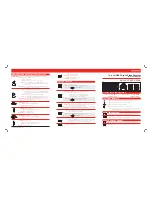
USER'S MANUAL
16
|
P a g e
Connect the cameras to the Video In ports located on the rear panel of the DVR using the proper cables
and connectors (BNC Twist Lock). The corresponding video channels can be “looped” out using the
“loop out” ports located beneath each video input port. There is no need for terminators to be installed,
each port is self terminated. Both NTSC and PAL signals are automatically detected by the DVR and
requires no further configuration. Please refer to the figure below.
Figure
8
Camera
input
and
loop
out
diagram
The loop out ports may be used to display the video signal from each individual channel to any desired
display output device such as a monitor or it can be used to provide a video signal to another DVR
system. The type of connection of the loop out ports use is BNC Twist Lock type.
Video Input Signals Specification
1 Vpp / 75 ohm
PAL / NTSC Auto Detect
BNC
Inputs
With
Loop
Out
The audio connections of DVR are used for both recording and monitoring purposes. You have the
option to disable both audio recording and monitoring functions in the “Audio Setup Menu”.
Both 8 and 16 channel models support up to 4 audio input channels and 1 audio output channel, as well
as 1 port for microphone input. Connect using RCA/Composite audio compatible cables with compatible
RCA/Composite audio connectors.
Figure
9
Audio
Input
/
Output
and
Microphone
Connection
example
Input Signal
Mono RCA, 1Vpp, 10 k ohm
Specifications
Output Signal
Mono RCA, 1Vpp, 10 k ohm
CHAPTER 3. HARDWARE CONFIGURATION
5. Camera Connections
CHAPTER 3. HARDWARE CONFIGURATION
6. Audio Connections
Camera
Inputs
Loop
Out
Connect using RCA/Composite audio compatible
cables with compatible RCA/Composite audio
connectors.
You
may
use
any
audio
output
device
such
as
a
speaker
system
that
supports
RCA/Composite
audio
inputs.
You
may
use
a
microphone
that
supports
RCA/Composite
Audio
connections.
Summary of Contents for H.264 Digital Video Recorder
Page 1: ......
Page 77: ...USER S MANUAL 77 P a g e...
















































